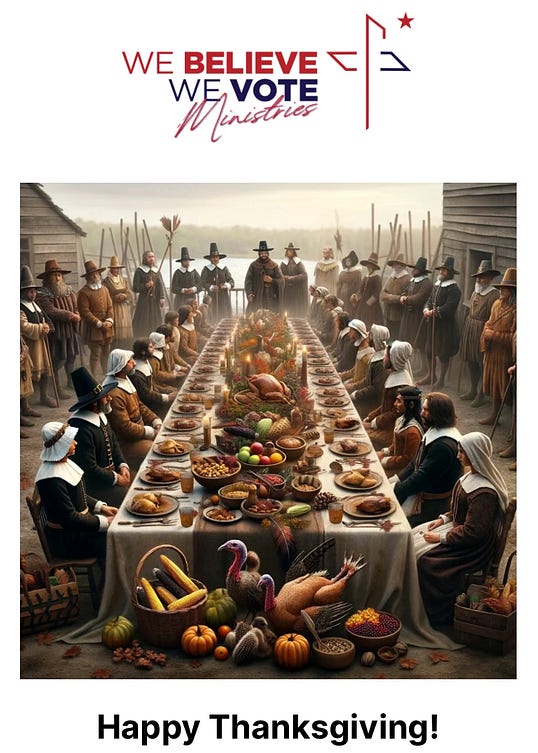Thanksgiving Remembered–Badly
Last week Wednesday, the day before Thanksgiving, the High Ground forwarded historian Heather Cox Richardson’s 2019 post detailing our modern-day Thanksgiving celebration’s origin in the Civil War—something we’re not taught in school. I recalled the Thanksgiving image presented in my childhood of noble, pristinely dressed Pilgrims and Indians around a table groaning under the weight of a Thanksgiving feast featuring a huge turkey.
The next day Professor Richardson offered more background on how we came to adopt the image of the Pilgrim’s feast:
In 1841 a book that reprinted the early diaries and letters from the Plymouth colony recovered the story of that three-day celebration in which ninety Indigenous Americans and the English settlers shared fowl and deer. This story of peace and goodwill among men who by the 1840s were more often enemies than not inspired Sarah Josepha Hale, who edited the popular women’s magazine Godey’s Lady’s Book, to think that a national celebration could ease similar tensions building between the slave-holding South and the free North. She lobbied for legislation to establish a day of national thanksgiving.
And then, on April 12, 1861, southern soldiers fired on Fort Sumter, a federal fort in Charleston Harbor, and the meaning of a holiday for giving thanks changed.
The national celebration of peace and goodwill imagined by Sarah Josepha Hale based on letters and diaries from more than two hundred years before was certainly well-intentioned—but we as Americans do ourselves a disservice by mythologizing the “first Thanksgiving”, to the exclusion of understanding and appreciating the actual history of the holiday.
The twisting of history through myth and imagery was vividly illustrated for me later in the day when I received this image from the locally-grown “We Believe We Vote Ministries” sent out with its Thanksgiving greeting:

Of all the stock depictions of the “first” Thanksgiving WeBelieveWeVote could not have chosen a more telling one. In the year from the time 102 Pilgrims landed at Plymouth in 1620 until this feast half of these immigrants had died of disease and starvation. They might have all died had it not been for food aid and education provided by members of several groups of local native Americans, groups that had themselves suffered epidemic death from Old World diseases that had coursed through native populations since first contact with Europeans.
The tale of peace and tranquility that Sarah Josepha Hale sought to popularize—and the one we were taught in school—featured the contribution of native Americans, particularly Tisquantum (Squanto), to the survival of the remnant Pilgrim band. In contrast to actual history, WeBelieveWeVote’s chosen stock photo retells a myth verging on a lie—a lie that all but erases the pivotal native American contribution to the Pilgrim’s survival and the Thanksgiving story. Look carefully. Perhaps the diminutive third person at the table in the right foreground is meant to suggest a native. The only other might arguably be the misty, fading individual depicted in the back row.
The choice of this particular stock photo, whether intentional or not, fits the Fundamentalist narrative to which the people of WeBelieveWeVote adhere and with which they seek to electorally dominate. “The Holy Bible is the supernatural, full, and inspired Word of God; it is inerrant, supreme, and final.” is listed first among their list of “core values”. There is no room in that core value to acknowledge the wisdom and aid of native Americans. In this mythology, the particular chosen ascendant Christians settled on this barely occupied pristine land God made available. Those pesky native Americans simply fade into the background.
With this mythic portrait of the first Thanksgiving it is the smallest of wonders that so many Christians of this particular Fundamentalist ilk are happy to legislate against teaching “DEI”, diversity, equity, and inclusion; references to the inhumanity and lasting legacy of slavery, racism, and settler colonialism; and the availability to anyone of any book that doesn’t quite fit with their view of history, geology, biology, and sex.
Keep to the high ground,
Jerry
P.S. For additional appreciation of how we’ve come to celebrate Thanksgiving in the way we do I recommend this article on History.com.
P.P.S. The Fundamentalist faith in Biblical inerrancy is circularly based in II Timothy 3:16-17. From the King James version of the Bible: “All scripture is given by inspiration of God, and is profitable for doctrine, for reproof, for correction, for instruction in righteousness: That the man of God may be perfect, thoroughly furnished unto all good works.” This verse comes from a letter written by one missionary to another in which the first conveniently claims divine inspiration for “all scripture”. Considering that at the time of writing of this second epistle to Timothy the collection of books and writings later called “the Bible” was not yet even defined, what does “all scripture” even mean?